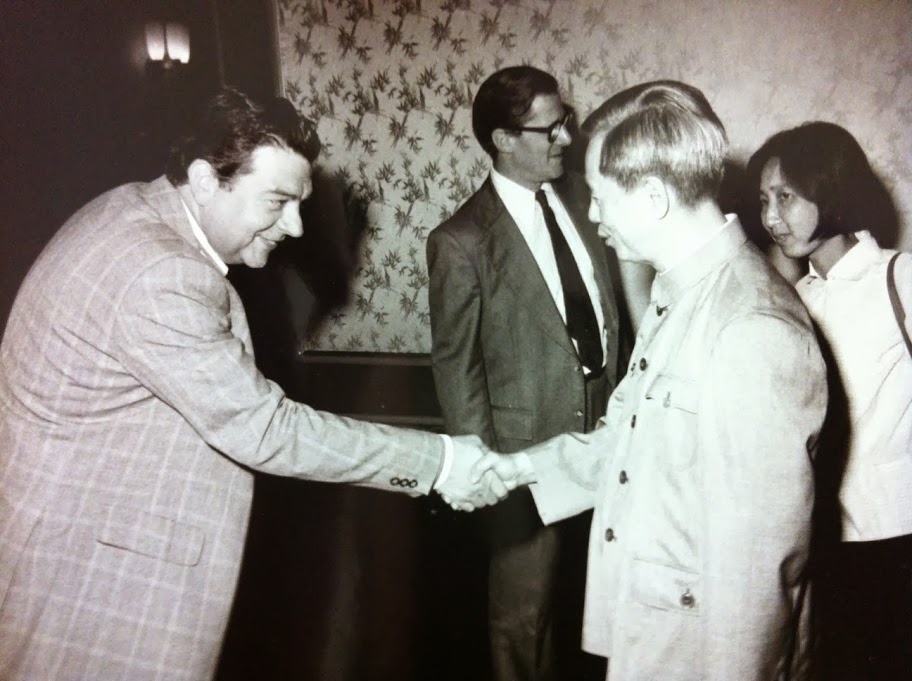Among recent donations to the Bodleian Library is a stunning lace edged silk cushion cover, now part of the Weston Library Special Collections under shelf mark MS.Chin.a.25. Delicately embroidered with floral patterns and measuring about two feet long and wide, the piece features a calligraphed dedication in Chinese and, at its centre, a watercolour painting reading “Memories from Péronne” in French.
It is no coincidence that the name of Péronne should immediately evoke the history of the First World War through its association with the Battle of the Somme. Pictured above (Figure 1), the cushion cover was gifted during the war by Zhang Jiantang, a Chinese interpreter and medical dresser enrolled in the Chinese Labour Corps, to Frederick Jones (1890-1975), Serjeant Shoemaker serving with the Royal Army Medical Corps (RAMC) in France.
In recent years, historians of China and Europe have shed increasing light on the long-forgotten role of an estimated 140,000 Chinese men who were sent to Europe to perform manual and support labour between 1916 and 1920. As the French and British governments were being faced with hefty war casualties and acute manpower shortages, they negotiated agreements to recruit Chinese labourers, who then became enlisted as part of the colonial troops administered by the French Ministry of War, or as part of the Chinese Labour Corps (CLC) under the British Expeditionary Forces. These men performed a variety of tasks including factory, agricultural, building, and demining work, before being sent back to China around 1918-1920. Among them, an estimated four to five hundred were formally enrolled as interpreters, with many more who, through linguistic skills acquired at various stages of their lives, performed translation and interpreting duties on top of other tasks.
Among the latter was Zhang Jiantang, who signed as “dresser and translator at the Chinese hospital in France” on the cushion cover that he presented to Frederick Jones. The embroidered piece was a gift for Serjeant Jones to bring back to his wife, Annie Lydia Durbin, whom he had married in January 1916 during a short permission home to Fulham, London. The inscription in Chinese reads as a powerful testament to the deep friendship that developed between the two men, despite them having known each other for a mere two months, and despite the “far-reaching racial and linguistic differences” which should have separated them.

Wedding picture of Frederick Jones and Annie Lydia Durbin, January 1916. Private family collection, courtesy of Ms. Iris Jones.
In all likelihood, the mention of “Chinese Hospital” on the dedication should point towards the two men having met at the No. 3 Native Labour General Hospital in Noyelles-sur-Mer, which was set up in April 1917 as the “Chinese Hospital” before being renamed as part of a larger system of native labour hospitals for colonial workers. The Noyelles hospital was by far the largest on the Western Front employing and treating Chinese labourers. However, several other medical institutions did employ Chinese personnel, and records show that Chinese medical assistants were often transferred from Noyelles to other institutions when practical needs arose. In particular, the N°7 Native Labour Hospital in Le Havre did employ a sizeable number of Chinese workers, as well as a Serjeant Jones from RAMC who reported for duty in August 1918 from the neighbouring 52nd stationary hospital.
Hospitals, of course, have been described as a key site which both affirmed and questioned colonial and racist hierarchies during the First World War, as well as perhaps one of its most intimate places of encounter (Maguire 2021). Despite the segregation in place and despite frequent descriptions of Chinese medical staff as “lacking knowledge and discipline” in various war diaries of field hospitals, the amount of care, work, and language skills that went into the creation of such a gift in wartime keep reminding us of the importance of looking beyond Eurocentric administrative archives for writing deeply textured, human sized histories of the First World War.
While the exact geographic origin of the cushion cover cannot be pinpointed yet, working alongside Chinese medical workers undoubtedly left a deep impression on the RAMC Serjeant. His daughter, who turned a hundred and one years old this year, still remembers vividly the deep impression that Chinese stretcher-bearers left on her father, and the soothing words in Mandarin that he picked up from them – words that still soothe her to this day.
Coraline Jortay
Laming Junior Research Fellow
The Queen’s College
Our grateful thanks go to Ms. Iris Jones, Frederick Jones’ daughter, for this wonderful gift to the library.
Sources:
Oral history interview conducted by Dr. Coraline Jortay (Laming Junior Research Fellow, The Queen’s College) with Ms. Iris Jones on 9th October 2022; Jones family papers; UK National Archives WO 95/4115 and WO 372/11.Further readings on the history of Chinese labourers in the First World War:
Chen San-ching, Huagong yu ouzhan, Taipei: Academia Sinica, 1986.
Dendooven, Dominiek. Asia in Flanders Fields. A Transnational History of Indians and Chinese on the Western Front, 1914-1920. University of Kent, 2018.
James, Gregory. The Chinese Labour Corps:(1916-1920). Hong Kong: Bayview, 2013.
Li Ma. (eds.). Les Travailleurs chinois en France dans la Première Guerre mondiale. Paris: CNRS, 2012.
Xu, Guoqi. Strangers on the Western Front: Chinese Workers in the Great War. Cambridge: Harvard University Press, 2011.Further readings on the colonial politics of WWI Hospitals:
Buxton, Hilary ‘Imperial Amnesia: Race, Trauma and Indian Troops in the First World War’, Past & Present, 241 (2018).
Hyson, Samuel and Lester, Alan ‘“British India on Trial”: Brighton Military Hospitals and the Politics of Empire in World War I’, Journal of Historical Geography, 38, 1 (2012).
Anna Maguire, ed., ‘On the Wards: Hospitals and Encounters’, in Contact Zones of the First World War: Cultural Encounters across the British Empire. Cambridge: Cambridge University Press, 2021, 153–76.

![Black and white portrait of Sir Stafford Cripps, c. 1947 [Dutch National Archives, The Hague, Fotocollectie Algemeen Nederlands Persbureau (ANEFO)] [Creative Commons CCO 1.0]](http://blogs.bodleian.ox.ac.uk/archivesandmanuscripts/wp-content/uploads/sites/161/2021/04/518px-Stafford_Cripps_1947.jpg)

